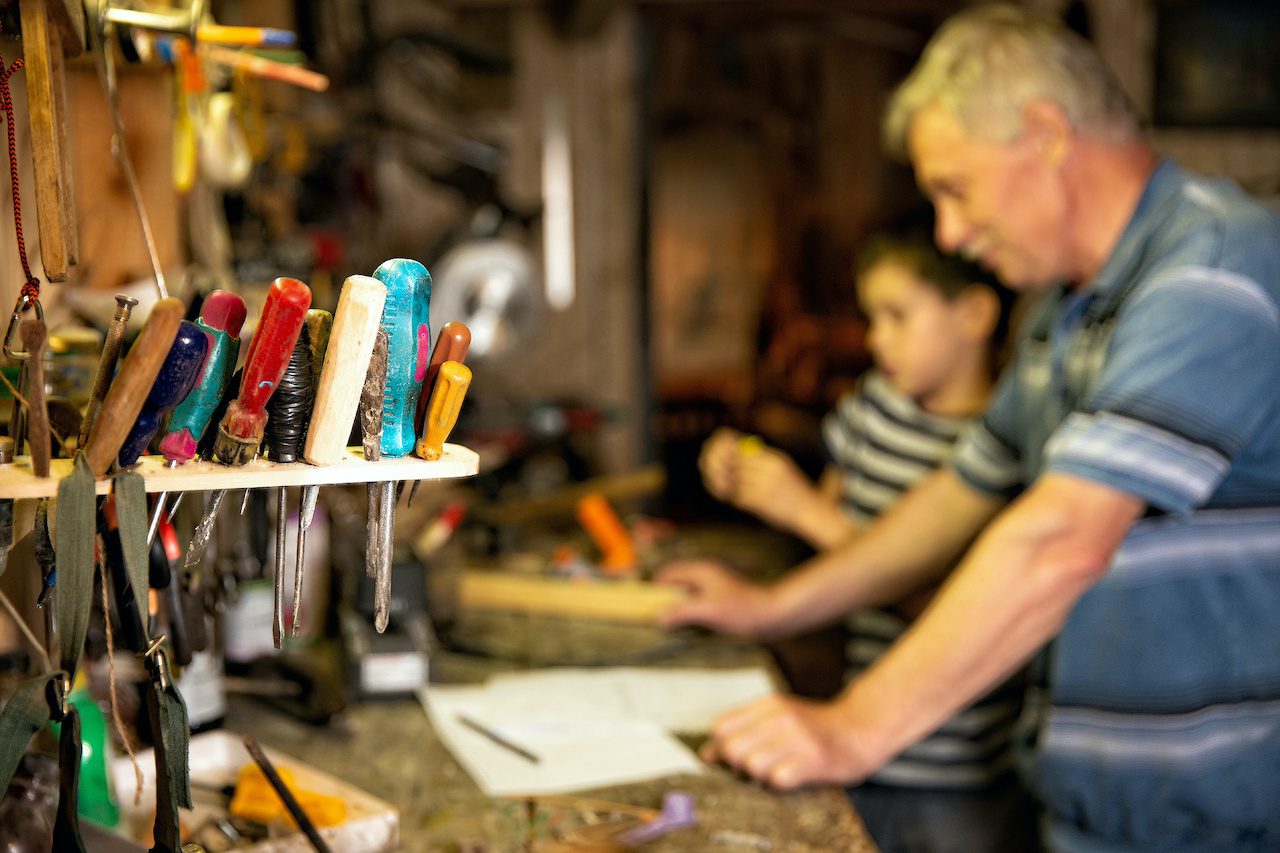
What to do when an opener runs, but the garage door isn’t moving.
If your garage door opener runs when you use your remote or wall-mounted button, but the door itself won’t open, the issue might not be perfectly clear.
For a closer look at potential challenges with your garage door opener, Overhead Door Company of Huntsville/North Alabama™ has compiled this in-depth guide. It’s designed to assist our local homeowners in Huntsville, Madison, and the surrounding metro areas of North Alabama in understanding and addressing these issues.
Your Garage Door Opener Runs, but the Door Won’t Open
There are two main reasons why your garage door isn’t opening.
- The first problem could be with the motor itself. Your garage door opener could have a broken part or gear that needs to be repaired or replaced.
- The other possible problem is your garage door could be failing to engage with your opener.
Let’s take a closer look.
Find the emergency release
The first step is to locate the emergency release and disengage it, do it only if the garage door is completely closed.
If the emergency release is jammed, you’ll need to get a garage door technician to repair it.
All garage doors have a manual disconnect. If you’re not sure where yours is, take a look at your manual for your garage door opener, as this should have the answer for you.
In most cases, the emergency release hangs down from the trolley on a red rope. Tugging down on the rope disconnects the trolley from the garage door opener, preventing the door from moving. When the opener is disengaged, the garage door opener will run, but the door will remain in place.
The next step is to attempt to open your garage door manually. Manually opening a garage door will determine if the issue is connected to the garage door itself or the opener.
If you can manually raise your garage door with ease, the garage door itself is not the problem. This indicates that something in the opener system has malfunctioned. A professional garage door technician will be able to tell you whether it is best to replace the opener or repair the old one.
Rule out the opener.
- Firstly, check that the garage door isn’t locked.
- Inspect your garage door to determine if it’s running smoothly along the garage door tracks. With the garage door disengaged, this might allow you to see what’s causing your garage door to get stuck. It might be a kink in the track, a bad roller, or an obstruction. Sometimes, a simple fix will do the job. Other times, you might need to call a professional, especially in the case of a bent or damaged track.
- Take a look at your garage door springs. These are what give your garage door the tension needed to open. Garage door springs are typically rated at 10,000 cycles. If the spring breaks, your opener will no longer be able to lift your garage door. In most cases, the garage door motor will keep trying. Note: Most garage doors have a torsion spring (a large spring situated directly above the door), but many older garage door systems will have a pair of extension springs, which are located above the upper tracks on either side of the door.If the garage door spring system is broken, don’t attempt to fix it yourself. Springs hold a tremendous amount of tension, so it’s best to contact a trained professional if repair is needed. If you experience a broken spring, do not attempt to lift the door manually or with the assistance of the electric opener. Without the aid of a proper spring, the door will become extremely heavy and difficult to lift manually. Attempting to lift the door by hand with a broken spring could cause you personal harm.
Furthermore, attempting to open the broken door with the electric opener will likely cause further damage. Garage door openers are manufactured to lift doors only with the assistance of the garage door spring. If the spring is broken, continuing to use the opener will likely burn out the motor. If your garage door opener is running but the door won’t open, and you feel springs are the issue, please call us immediately.
- Check pulleys and cables to ensure that they haven’t snapped or become loose. If you see anything that doesn’t look quite right, again, call in a repair expert to handle it for you.
- The garage door’s too heavy for the opener. If you’ve recently replaced your opener or garage door, it is possible the two are not compatible. The opener might not be powerful enough to handle the size and weight of your garage door. This problem will sometimes arise as a result of a do-it-yourself installation. We can help you with this problem. Call us if your garage door opener runs but the door won’t open, especially if you have determined the garage door is too heavy for the opener.
- Chain Too Tight – If the chain was installed too tightly on the garage door opener, it can make opening the door more difficult for the automatic opener. This excess tension causes the gear that moves the chain to grind down. If the gear becomes too worn, it will no longer be able to move the chain. In this case, the motor will run and the gear will turn, but the chain will not move and the door will not open.
Once you’ve made these checks, make sure that you’re reconnecting the emergency release to keep your garage door safe.
To re-engage your opener, please refer to your owner’s manual. Do not pull on the rope if the garage door is in the open or partially open position because if you do, it might release the garage door into a falling pattern. If the garage door has a broken spring or is out of balance, the garage door could close very rapidly, resulting in a serious injury or death if someone is underneath the garage door. Also, improperly reconnecting the emergency release could cause serious damage to the garage door.
Re-engaging the trolley is simple. You pull the emergency release rope up and back toward the opener on most garage door systems to cause the trolley to snap back into place. Align both trolleys together, and it will snap back into place automatically. Again, please consult your owner’s manual.
The garage door opener is the problem.
So you’ve made all these checks, but it’s not your garage door that’s causing the problems. There’s something wrong with the garage door opener that’s stopping it from opening the door for you.
- You might have a defective or broken part within the motor itself. It’s time to step back and listen. If the chain, belt or screw is not moving after hearing the motor inside your garage door making a sound like it’s turning, you might have a defective or broken part within the motor itself. If your find your garage door opener in this situation, it’s time to call a trained service technician to repair the garage door opener.
- In most cases, the cause will be a stripped gear or a chain that has come off the sprocket. If this is the case, the motor will run, but as the chain isn’t where it should be, it can’t generate the lift to open the door.
- You may also find that your motor won’t work as the emergency release has become jammed. This will happen if the chain or belt moves, but the door won’t open. As the release is stuck, it can’t allow the door to open. Again, you’ll need an expert to come and put this right.
- If your opener is five years or older, it was most likely programmed with a specific amount of force needed to pull the garage door up. Over time, that amount of force might need to be increased to compensate for damage to the tracks or the door rollers, either of which makes it difficult for the opener to lift the door.
A nut located on the opener—check your owner’s manual for location, which varies by brand—can be turned with a wrench to increase the opener’s pulling power.Using too much force will put excess strain on opener components like the nylon drive gear. Never crank up the dials – doing so could damage your garage door opener or top door section.
By increasing the pulling force, the opener may be able to open the door again. On older units, forces are set by a dial numbered 1 to 9, while newer units often have built-in automatic force recognition.Having to increase the opener force is usually a sign of an underlying issue with the balance of the door. If you have recently replaced your torsion springs there is a good chance the door isn’t properly balanced.If you are not familiar with what you are doing, this is not advisable. A properly balanced residential garage door can be opened and closed with less than 15 pounds of force.One of the worst mistakes made by homeowners is inching up the force settings resulting in more issues with your garage door operating system or the top garage door section itself.
General Summary As to Why Your Garage Door Won’t Open
- Malfunctioning Remote Control: Dead batteries or remote signal problems.
- Misaligned Photo Eye Sensors: Blockages or misalignments preventing operation.
- Broken Springs: The door won’t lift if torsion or extension springs are damaged.
- Obstructions in the Track: Debris or damage can impede door movement.
- Faulty Opener: Issues with the garage door opener or its settings.
- Disconnected Emergency Release: The door may be detached from the opener mechanism.
- Worn or Broken Cables: Compromised cables can prevent door operation.
- Broken Chain: A snapped or damaged chain can stop the door from being lifted.
What To Do If Your Garage Door is Stuck!
Now what? You may not have the appropriate experience or time for this repair.
The chances are you might not have complete knowledge of how a garage door operates or how all the hardware components interact and function together. Put your toolbox away, pick up your phone and call Overhead Door Company of Huntsville/North Alabama™ if your garage door opener runs but the door won’t open. We’d love to help.
At Overhead Door Company of Huntsville/North Alabama™, we offer excellent customer service and affordable pricing, we’re the best people to serve you.
For further insights on various garage door operational challenges, explore our Quick Troubleshooting Guide.
Safety Precaution
Before going any further, we want to be clear. Garage doors can be dangerous, and it’s not uncommon for people to get injured while attempting any garage door repairs. Even experienced technicians with years of experience should work with caution, as it is in the highest insurance classification for a work-related injury. This is not a garage door safety guide and cannot account for every garage door situation. Always proceed with caution. When in doubt, leave the job to garage door professionals. They are familiar with the dangers of working with a garage door, hardware, and all of its moving parts.
If you decide to operate the garage door manually, we recommend that you either close or brace the door before pulling the release cord and that nothing is in its operating path. If you attempt any adjustments, do not loosen or remove any part of the door or hardware that is under spring tension or the weight of the door. Make sure the door is not jammed. Check that its path is clear and unobstructed before operating the motor.



